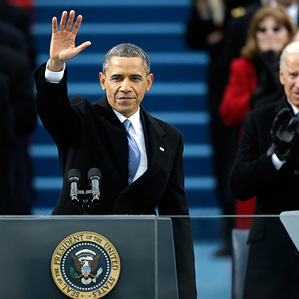Energy Funding Outlook Looks Bleak as Obama Begins Second Term
As a result of impending mandatory spending cuts known as sequestration, the first 100 days of President Obama’s second term couldn’t be more different from those of his first. If sequestration kicks in, federal support for clean energy, which received a $90 billion jolt from the stimulus package four years ago, is likely to decrease, even though the need for energy breakthroughs to cut carbon dioxide emissions is clearer than ever (see “Solving Global Warming Will Require Far Greater Cuts than Thought”).

Under sequestration, across-the-board cuts would go into effect in March, and be followed by a decade-long funding cap. “The joke is that flat is the new doubling,” says Thom Mason, head of the Oak Ridge National Laboratory, the largest science and energy lab in the U.S. Department of Energy’s system. “The fact that it’s really important and a high priority means you don’t get killed.”
The mandatory cuts are a component of the so-called fiscal cliff—a combination of tax increases and across-the-board discretionary spending cuts that had been scheduled to begin in January. A deal at the end of 2012 prevented some of those tax increases. It also pushed the mandatory cuts back to March and slightly lowered the size of the cuts for this year. The mandatory cuts could be avoided by Congress, but key congressional staffers say that looks unlikely.
The American Association for the Advancement of Science (AAAS) has analyzed the impact of the cuts on R&D. Originally, the cuts would have lowered defense-related R&D by 9.1 percent and non-defense R&D, such as at the DOE, by 7.6 percent. As a result of the tax deal, the cuts are lowered for fiscal year 2013 to 7.6 percent for defense and 5.1 percent for non-defense R&D, but the full cuts would go into place next year. After that, spending is supposed to stay flat for a decade.
If the across-the-board cuts happen, they will affect all parts of federal energy R&D, including programs at national labs and federally funded research at companies and universities. Because the sequestration would go into effect halfway through the fiscal year, the cuts for the entire year will need to be taken out of the budget for the second half of the year, making the effective cuts much higher for the second half, Mason says.
It’s also not clear how much flexibility agencies will have to move money around to protect high-priority programs. Joanne Carney, director of the office of government relations at AAAS, says that, strictly speaking, the money couldn’t be moved around—since the law calls for across-the-board cuts. Of course, Congress has the power to change the law if it wants to.
Avoiding sequestration would require a focused effort on the part of the Obama administration, and would likely require finding alternative ways to achieve similar overall cost reductions. One way to protect R&D might be to siphon money away from some subsidy programs, says Robert Atkinson, president of the Information Technology and Innovation Foundation. For example, current subsidies for wind currently go mostly to established technologies. Shifting that to funding for next generation offshore wind turbines could have a bigger impact on clean energy innovation, he says.
Keep Reading
Most Popular
Large language models can do jaw-dropping things. But nobody knows exactly why.
And that's a problem. Figuring it out is one of the biggest scientific puzzles of our time and a crucial step towards controlling more powerful future models.
The problem with plug-in hybrids? Their drivers.
Plug-in hybrids are often sold as a transition to EVs, but new data from Europe shows we’re still underestimating the emissions they produce.
Google DeepMind’s new generative model makes Super Mario–like games from scratch
Genie learns how to control games by watching hours and hours of video. It could help train next-gen robots too.
How scientists traced a mysterious covid case back to six toilets
When wastewater surveillance turns into a hunt for a single infected individual, the ethics get tricky.
Stay connected
Get the latest updates from
MIT Technology Review
Discover special offers, top stories, upcoming events, and more.